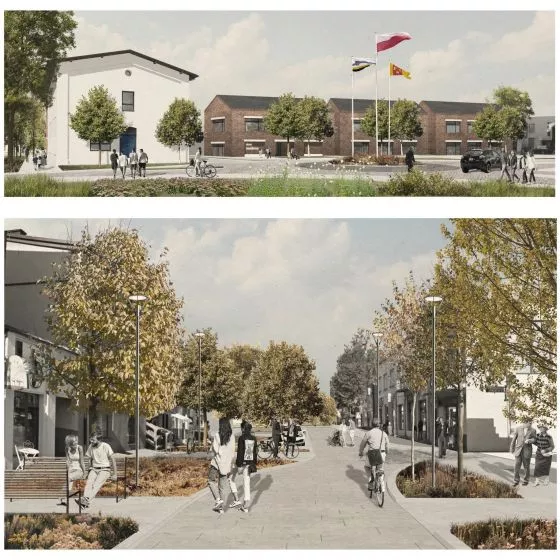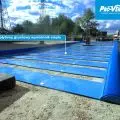The 5th anniversary edition of the Open Eyes Economy Summit is behind us! During two intensive days, despite the new hybrid edition, the congress was attended by as many as two and a half thousand people from twenty countries. Architecture & Business took patronage of the CITY-IDEA track, where, together with invited guests, we reflected on architecture and the adaptation of cities to progressive climate change.
This year's edition, held on November 17 and 18 at ICE in Cracow, was very different from previous ones. Due to the pandemic and prevailing restrictions, the organizers decided on a bold move - moving the entire event online. In the ICE Krakow Congress Center, only the presenters, some speakers, organizers and... dummies. Despite this formula, the congress was extremely popular - two and a half thousand participants, actively taking part in lectures, sessions, skirmishes and networking, proved that we are perfectly comfortable with the new normal!
economy of values
The intensive two days centered around the theme of value economics, were divided into four thematic blocks:
- COMPANY - IDEA,
- CITY - IDEA (under the auspices of A&B),
- BRAND - CULTURE,
- International governance.
During the opening session, Prof. Muhammad Yunus, winner of the 2006 Nobel Peace Prize, spoke about the fact that if we are to live in a world of equitably distributed wealth the vaccine for COVID must be available to everyone for free. Gdansk Mayor Aleksandra Dulkiewicz talked about solidarity as a recipe for good urban development, and Prof. Michael Inatieff of the Central European University spoke about the new direction the world should take.
CITY-IDEA path
From left: Malgorzata Tomczak, Agata Twardoch, on screen Malgorzata Bobrowska and Mariusz Kondraciuk,
Malgorzata Kuciewicz, Simone De Iacobis
Photo: Piotr Malec/OEES
In the COMPANY-IDEA block, we learned about the boundaries between property and value and considered the issue of common goods in a capitalist system. We found out that artificial intelligence is in fact already an everyday reality for us. In the MARK - CULTURE section, the speakers formulated a prescription for modern education, revealed the secrets of new teaching methods and showed the female role in education. They also agreed that the only chance for humanity to survive is to move from the Anthropocene to the Symbiocene. The International Order track dealt with the prospect of economic development in the near future, and we also considered whether we can survive without forests and vegetation.
architecture for new times
Architecture and Business accompanied the section titled CITY IDEA, in which we talked about architecture and the adaptation of cities to climate change. Wednesday's meeting began with a keynote speech by architect Nathalie de Vires, from the Dutch studio MVRDV, who touched, among other things, on the topic of greenery in cities. Austrian architect Dietmar Eberle spoke about smart design and the future of buildings.
Nathalie de Vires was connecting with OEES from Rotterdam
Photo: Dobrawa Bies © A&B
In the inspirational session titled Architecture for new times, together with Dr. Małgorzata Bobrowska and Mariusz Kondraciuk of Siemens Polska, CENTRALA Design Group and Dr. Agata Twardoch of the Silesian University of Technology, we considered changing the way we think in design, introducing diversity and taking into account the needs of other city dwellers - animals and plants. We also touched on greenwashing and social change. Moderator Malgorzata Tomczak, editor-in-chief of A&B, started the discussion by asking whether architects should build less? Or should they not build at all? Agata Twardoch answered that we should adapt architecture to climate change, inhibit adverse phenomena, make cities more subjective, and educate the public. Less is more Eco!
we should adapt architecture to climate change
Photo: Piotr Malec/OEES
Malgorzata Kuciewicz together with Simone De Iacobis of CENTRALA Design Group considered how nature can enhance architecture. They touched on Lo-TEK, or the use of simple, unprocessed materials, and vernacular architecture. They argued in favor of transforming existing objects rather than creating new ones. They talked about introducing hydrobotany into cities, ponds on rooftops, creating mud areas, and creating facades adapted to plant growth, regulating the microclimate. An important slogan was the creation of discomfort and the ability to give up some comforts (such as the use of seasonal refrigerators) the creation of chronobiological architecture and the awareness that we are not the only inhabitants of cities.
CENTRALA group raised the subject of Lo-TEK
photo: Piotr Malec/OEES
Małgorzata Tomczak, citing data on carbon dioxide emissions (construction is responsible for as much as thirty percent of atmospheric emissions), asked whether to talk about such a thing as ecological architecture at all? The guests jointly agreed that this is an oxymoron. Małgorzata Kuciewicz also mentioned the widespread awareness of the inevitable end, saying that now is the time to think about how to make this end more elegant. Using Poland as an example, we considered how to responsibly reduce carbon emissions in cities that are still geared toward unbridled development, and what cooperation between architects and local governments looks like. One important conclusion was that we know how to reduce emissions, but we are not yet able to implement this knowledge effectively. Hopefully, this will change soon.
questions and further discussion online
During all sessions it was possible to ask questions, comment online and be active in the chat room, due to time constraints the speakers did not manage to answer all of them, but we undertook to continue the discussion on the portal. There was a lot of interest in the activities of the CENTRAL group. Below you will read their responses.
Malgorzata Tomczak: How is wetscape and urban water, treated as an architectural component, a good answer to today's climate challenges?
CENTRAL: During hot weather, which is the biggest challenge, water is an ally; it cools, enhancing convection currents and urban air movement, reducing the heat island effect. Soaking places regulate the urban microclimate - during heavy rainfall they collect rainwater to give it back slowly, and during drought they provide the necessary amount of moisture. Wetlands are essential for fauna, guaranteeing biodiversity and thus stability of the ecosystem. Swamps that accumulate organic matter are also reservoirs and the most effective carbon sinks on Earth (they store it at an intensity of about 10 - 40 g C/m²/year), which is more efficiently than a primeval forest. We need to see the potential in even the smallest urban swamps.
Malgorzata Kuciewicz and Simone De Iacobis
Photo: Piotr Malec/OEES
MalgorzataTomczak: What needs to happen for designing buildings in the context of the climate crisis and thinking about this topic to become a design standard? What should architecture be for the new times?
CENTRAL: The role of architects is to promote, to refer to positive examples, to set a new standard. Let's not waste energy on stigmatizing practices from the previous era. JEMS competition proposals challenging norms, Sendzimir Foundation studies indicating solutions for urban space, mech.build studio balance architecture or projects for revitalizing the existing architectural fabric must become the new normal. A healthy trend will entail further realizations. We also support Kacper Kępiński's postulate that architects responsible for creating the terms of public competitions, or those judging competition entries, should promote ecologically responsible solutions.
Malgorzata Tomczak: You postulate thedesign of discomfort . How can all of us who live in and between buildings contribute to reducing CO2 emissions?
CENTRAL: What do we feel when walking around at dusk, when not everything is illuminated? Anxiety or interest in the activities of nocturnal animals? In an over-lit city we are unlikely to encounter them anyway. Do we need air conditioning, or is a draft enough? Can we spend a winter evening on a cool veranda? Appreciate that we are cold there, feel the passage of time, register the change of weather? Do we prefer to be cut off, to stay in a perfectly heated and lit living room, to miss the seasons, the aftermath of the seasons? We are not asking in terms of "helping" the climate, about the sense of this small overall reduction in energy consumption. We are pointing out the sense of training attention. Inconvenience allows one to participate more consciously in phenomena and see how quickly changes in nature occur. And with such experience comes increased motivation for action, such as political choices that can be causal.
On the next page we publish audience questions and further coverage of OEES.










































































